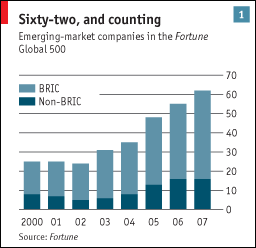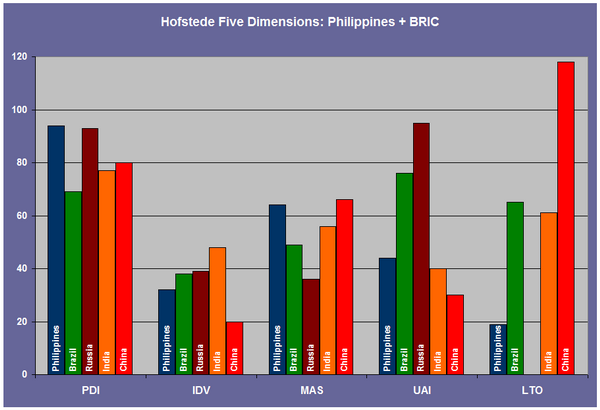 Globalization is entering a new phase, with emerging-market companies now competing furiously against rich-country ones. One sign of the times is the growing number of companies from emerging markets that appear in the Fortune 500 rankings of the world’s biggest firms. In 2008, it stands at 62, mostly from the so-called BRIC economies of Brazil, Russia, India and China, up from 31 in 2003 (see chart 1), and is set to rise rapidly. Mark Spelman, head of a global think-tank run consultancy, Accenture, onn current trends, emerging-market companies will account for one-third of the Fortune list within ten years (Bishop 2008).
Globalization is entering a new phase, with emerging-market companies now competing furiously against rich-country ones. One sign of the times is the growing number of companies from emerging markets that appear in the Fortune 500 rankings of the world’s biggest firms. In 2008, it stands at 62, mostly from the so-called BRIC economies of Brazil, Russia, India and China, up from 31 in 2003 (see chart 1), and is set to rise rapidly. Mark Spelman, head of a global think-tank run consultancy, Accenture, onn current trends, emerging-market companies will account for one-third of the Fortune list within ten years (Bishop 2008).
The term ‘BRIC economies’ was first used by Dominic Wilson and Roopa Purushothaman (2003) after mapping out GDP growth, income per capita and currency movements in the BRICs economies vis-a-vis the G6 countries [France, Germany, Italy, Japan, UK, and US] until 2050, predicted: “Over the next 50 years, Brazil, Russia, India and China—the BRICs economies—could become a much larger force in the world economy.”
Using the Geert Hofstede™ Cultural Dimensions web site, here is a comparison of Hofstede scores on the five dimensions for the Philippines vis-a-vis the emerging markets known as BRIC economies: Brazil, Russia, India and China.

Analyses
[PDI] Power Distance Index. Most culture of BRIC economies accept that power is distributed unequally, accepted from below, not imposed from above. Philippines [94] scored a point higher than Russia [93]. China [80] has a three-point advantage over India [77], while Brazil’s score of 69 is still above most other countries in the survey.
[IDV] Individualism Similar to ASEAN5, the culture of BRIC economies are also prone to collectivism. Even though the Philippines [32] scores the highest among the five original ASEAN member-nations signatories, it is above that of China [20] but below Brazil [38] and Russia [39]; and about 2/5-mark of India [48].
[MAS] Masculinity China [66], the Philippines [64] and India [56] moderately score high on masculinity values, whereby assertiveness, performance, success and competition are emphasized. Brazil [49] and Russia [36] tend to value more on the quality of life, maintaining warm personal relationships, service, care for the weak, and solidarity.
[UAI] Uncertainty Avoidance Index Russia [95] and Brazil [76] tend to minimize the possibility of novel or unstructured situations through strict laws and rules, safety and security measures, and a philosophical/religious commitment to the concept of absolute truth. Meanwhile, the Philippines [44], India [40] and, obviously, China [30] are more tolerant of different opinions, reflective and phlegmatic.
[LTO] Long-Term Orientation China [118] is a long-term culture which values thrift and perseverance. Brazil [65] and India [61] are moderately long-term oriented. Philippines [16] is a short-term culture which values tradition, the fulfilment of social obligations and protecting one’s ‘face’ or honor. No data was available for Russia, but a glimpse on the LTO estimated scores of other Eastern bloc countries could act as guide: Czech Republic [13], Poland [32], Slovakia [38] and Hungary [50].
Implications
The first three of the five Hofstede Dimensions, Power Distance Index [PDI], Individualism [IDV] and Masculinity [MAS] are all within the Philippines’s grasp to be an emerging market.
The Uncertainty Avoidance Index [UAI] is a good contrast between extremes, whereby two countries, namely India and China are at or below the 40-mark, the other two countries, namely Russia and Brazil are high above the 70-mark. Philippines [44] is just between these BRIC’s span.
The Long-Term Orientation [LTO], however, is quite revealing for the Philippines. Assuming Russia between 13 to 50, does it becomes an imperative for the Philippines to change its way of looking at its own orientation, i.e., to value more the long-term rather than the short-term orientation to be in the league of BRIC economies?
Notes:
Bishop, Matthew (2008). A bigger world, Special Report: A survey of Globalization. London: The Economist Newspaper Ltd, 18 September2008. back to text.
Hofstede, G. (1993). Cultural constraints in management theories. Academy of Management Executive, 1993. 7:1. pp. 81—94. back to text.
Hofstede, Geert (2001). Culture’s Consequences: Comparing Values, Behaviours, Institutions and Organizations across Nations. 2nd ed. Place: Sage Publications, Inc;, April 2001. 616pp. back to text.
Wilson, Dominic & Purushothaman, Roopa (2003). Dreaming With BRICs: The Path to 2050. Global Economics Paper No: 99. New York: Goldman Sachs Financial Workbench, 01 October 2003. back to text.
![]() Disclaimer: The posts herein do not necessarily represent any organization’s positions, strategies or opinions. Read the full version of self-imposed rules for this blog: A New Year; New Rules. Unless otherwise expressly stated, the posts are licensed under a Creative Commons Attribution-Noncommercial-No Derivative Works 3.0 License.
Disclaimer: The posts herein do not necessarily represent any organization’s positions, strategies or opinions. Read the full version of self-imposed rules for this blog: A New Year; New Rules. Unless otherwise expressly stated, the posts are licensed under a Creative Commons Attribution-Noncommercial-No Derivative Works 3.0 License.
Comments are moderated to keep the discussion relevant and civil. Readers are responsible for their own statements.


